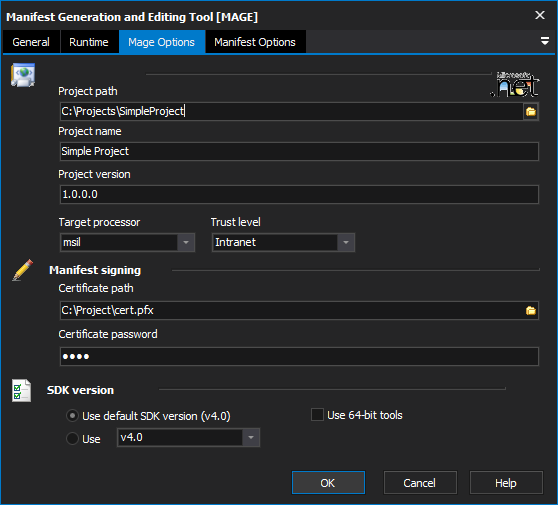Manifest Generation And Editing Tool [MAGE] Action
The Manifest Generation And Editing Tool action enables the creation and editing of application and deployment manifests.

MAGE Options
Project Path
The full path of the project files.
Project Name
The name property will be used to identify the application within the Start Menu, and in the Permission Elevation dialog boxes.
Project Version
The version of the deployment. This value does not correspond to the applications version. The value must be entered in the format of N.N.N.N, for example 1.0.0.0
Target Processor
The target architecture on which the application will be run. Default value is 'msil' which is platform-independent.
Trust Level
The level of trust to allow the application on client computers.
Manifest Signing
Certificate Path
The location of the certificate that will be used to sign the manifest.
Certificate Password
Used only in conjunction with the certificate path, allows the use of password protected certificates.
Framework Version
Use default framework version (vX.X) / Use vX.X
Allows the selection of the .NET version to use for the tool. The minimum is .NET v2.0.
Use 64-bit tools
This options specifies as whether to force the usage of 64-bit tools on a 64-bit system or not. As FinalBuilder is currently a 32-bit application it will default to running the 32-bit version on a 64-bit system. Check this option if you require the 64-bit version to be run.

Manifest Options
Manifest Options
Application Manifest
An application manifest is an XML file that describes an application that is deployed using ClickOnce
Filename
Specify the output file for the manifest. Default filename is 'application.exe.manifest'.
Application Files
The full path of the files that will be deployed using ClickOnce.
Deployment Manifest
A deployment manifest is an XML file that describes a ClickOnce deployment, including the identification of the current ClickOnce application version to deploy.
Filename
Specify the output file for the manifest. Default filename is 'deploy.application'.
Application Manifest Path
The full path to the application manifest file, which will be used to generate the deployment manifest.
Provider Url
The Url that ClickOnce will use to check for application updates.
Allow Local Install
Indicates wether the application should be installed on the client machines, or run from the web.
Update Manifest
Make alterations to an existing manifest.
Target Manifest
The full path to the manifest that is to be updated.